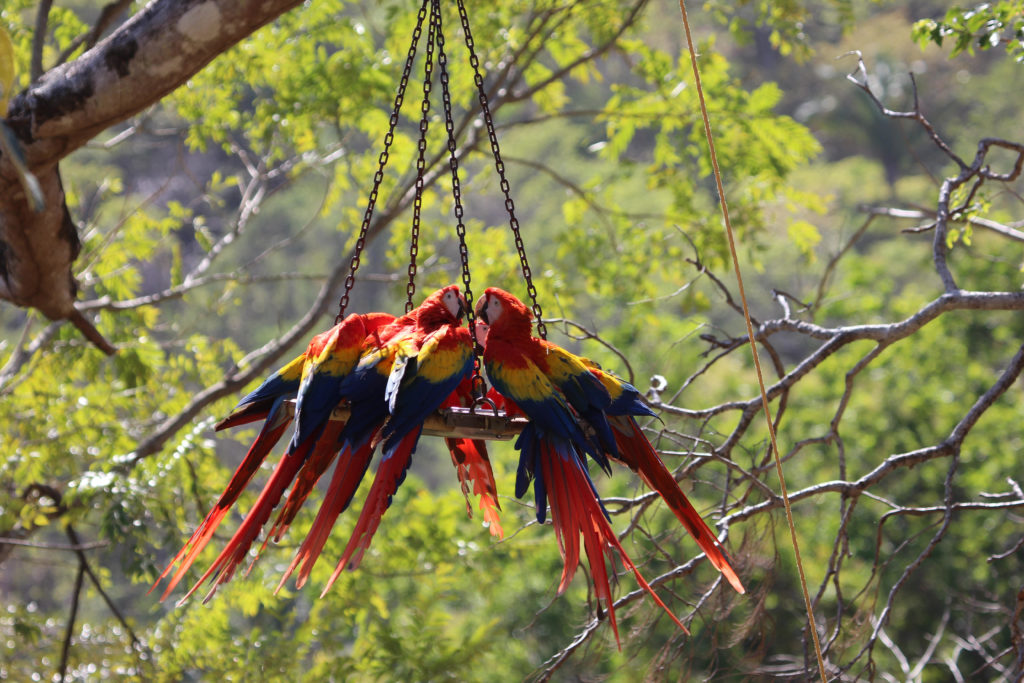
Food For Thought.
The Scarlet Macaw was once extinct in the Punta Islita area but thanks to Macaw Recovery Networks successful breeding and reintroduction programs are now beginning to slowly recover. During my first week as an apprentice at the Punta Islita Refuge & Breeding Center, I was assigned to feed the wild previously released Scarlet Macaws. Although these birds have been prepared for life in the wild, they still need help during their transition from captivity to the wild. To improve their chances of survival we offer them a supplementary feeding twice a day, this in total makes up to 10% of the bird’s daily food intake.
Each week one volunteer is responsible for giving the wild birds their food and water, and this was my job during my first week. As well as actually feeding the birds, part of my role was to monitor their behaviour before and after feeding, to track the number of wild birds that use the supplementary food. Whilst monitoring the macaws, I noticed one particular pattern of behaviour that was occurring daily. At every feed I would split the food equally into two trays, however each time a pair of macaws would dominate one of the feeders and chase off any other birds trying to feed there. This left the rest of the birds, which could be up to nine individuals, to share one tray. After speaking with the volunteers who had previously been monitoring the wild birds, I learnt that this had been happening for around three weeks.
I noticed that this pair would always dominate the same feeder, so in attempt to even out how much food all the birds were receiving (and out of curiosity to see how the pair would respond), I started distributing the food unevenly, putting less food into the tray that the pair were defending. I found that the pair quickly learnt how to get around this, they would behave in the same way initially and dominate their usual spot. However, once they had eaten the now smaller portion of food they would move to the other feeder and again chase off all the other birds.

Watching this behaviour repeat every day made me start thinking about the dynamics and social structure of wild Scarlet Macaw groups, and I was curious about why certain individuals would monopolise food resources in this way. As a social species, I questioned why they were unwilling to cooperate whilst foraging for food. I began to research the group behaviour of Scarlet Macaws and discovered that within their social groups they form important dominance hierarchies.
Older, aggressive breeding males tend to be higher ranking and will often be aggressive towards lower ranking individuals who, in response, tend to avoid these aggressive flock members. Females that are paired with the dominant males are also very dominant and aggressive when they are in close proximity to the male (typically within 2 feet), but are much lower ranking when they are further away from their mate. These dominant individuals are known to chase lower ranking individuals away from food sources and will behave aggressively in order to reinforce their position in the group. Young males can also become particularly aggressive when they are around 4-5 years old in order to assert themselves and try to position themselves as high up as possible within the social hierarchy. Sometimes these young males will form relationships with other males that are similar in age, strength and social standing, creating small coalitions of feisty young males trying to boost their ranking.
This research has led me to two possible conclusions about the dominant pair of Scarlet Macaws at the supplementary feeding trays. My initial thought was that they could be a male and female breeding pair where the male is high ranking and the female also becomes more dominant in his presence, which is why they both aggressively chase the lower ranking birds away from the other feeder. On the other hand, it could be a pair of young males trying to assert their dominance and secure a high ranking position within the hierarchy. It is impossible to identify the sex of a Scarlet Macaw simply by looking at them because, to the human eye, males and females look the same, and so I can’t say with any certainty which conclusion is more likely.
However, the male coalitions are often comprised of more than two individuals, and since it is currently the breeding season for Scarlet Macaws, I suspect that this is a breeding pair. By monopolising this food source they are maximising their own fitness and are more likely to breed successfully and raise healthy offspring which in turn have higher chances of survival. If this is a breeding pair, this is a very positive sign that the birds we have released are breeding and this is very promising for the recovery of the wild population. Hopefully our field biologists will be able to monitor these two birds, confirm if they are a breeding pair, and track their movements and behaviour in the coming months.
Author: Mirran Trimble
Mirran is a 2019 Great Green Macaw Apprentice at the Punta Islita Refuge & Breeding Center.
Like our Facebook Page for more updates!